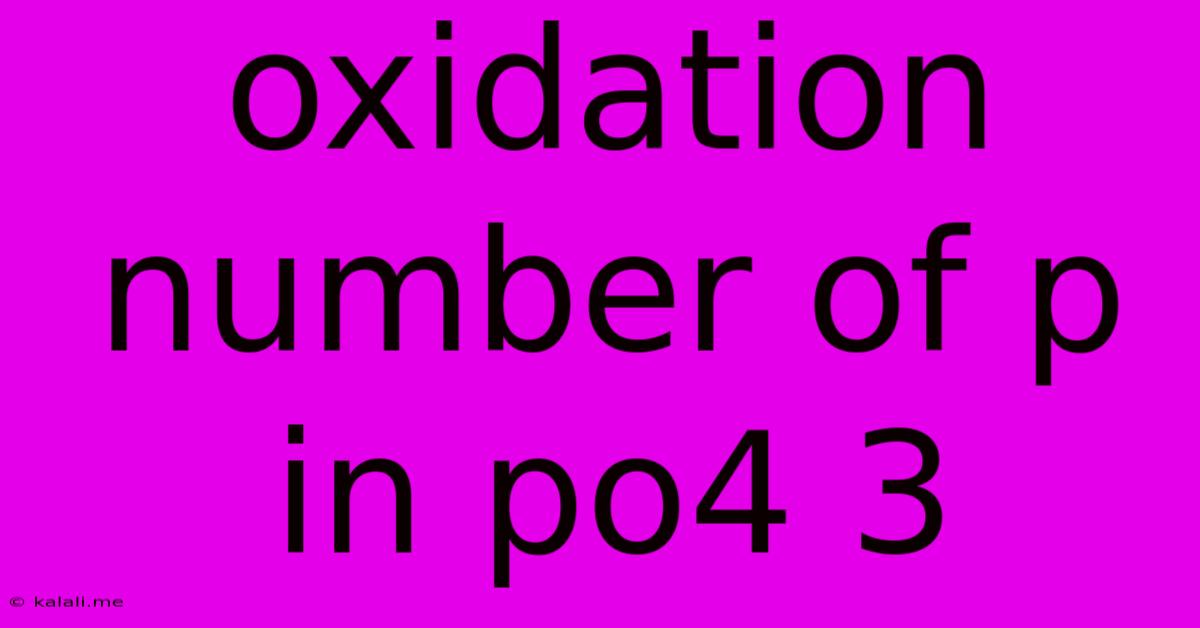Oxidation Number Of P In Po4 3
Kalali
Jun 12, 2025 · 3 min read

Table of Contents
Determining the Oxidation Number of Phosphorus (P) in PO₄³⁻
This article will guide you through the process of calculating the oxidation number of phosphorus (P) in the phosphate ion, PO₄³⁻. Understanding oxidation numbers is crucial in chemistry, especially when balancing redox reactions and predicting the properties of compounds. This seemingly simple calculation offers a great opportunity to understand fundamental chemical principles.
What is an Oxidation Number?
Before we dive into the calculation, let's define oxidation number. The oxidation number, also known as oxidation state, is a number assigned to an atom in a molecule or ion that represents its apparent charge. It indicates the number of electrons an atom has gained or lost compared to its neutral state. It's a useful tool for tracking electron transfer in chemical reactions.
Calculating the Oxidation Number of P in PO₄³⁻
To determine the oxidation number of phosphorus in the phosphate ion (PO₄³⁻), we'll use a systematic approach:
-
Identify the known oxidation numbers: Oxygen (O) almost always has an oxidation number of -2 in its compounds, except in peroxides (like H₂O₂) where it is -1. Since we're dealing with a typical phosphate ion, we'll assign oxygen an oxidation number of -2.
-
Assign a variable to the unknown oxidation number: Let's represent the oxidation number of phosphorus (P) with the variable 'x'.
-
Set up an equation: The sum of the oxidation numbers of all atoms in a polyatomic ion must equal the overall charge of the ion. In the case of PO₄³⁻, the overall charge is -3. Therefore, we can set up the equation:
x + 4(-2) = -3
-
Solve for x:
x - 8 = -3 x = +5
Therefore, the oxidation number of phosphorus (P) in the phosphate ion (PO₄³⁻) is +5.
Understanding the Result: Implications of the +5 Oxidation State
The +5 oxidation state of phosphorus in PO₄³⁻ reflects phosphorus's ability to lose five electrons. This high oxidation state indicates that phosphorus is highly oxidized in this ion. This contributes to the strong oxidizing power of some phosphate compounds and influences its reactivity in various chemical reactions. The high electronegativity difference between phosphorus and oxygen also plays a significant role in determining the oxidation states.
Further Applications and Extensions:
Understanding the calculation of oxidation numbers extends beyond simply determining the oxidation state of phosphorus in PO₄³⁻. This fundamental concept is applicable to a wide range of chemical compounds and ions. Mastering this skill is essential for:
- Balancing redox reactions: Oxidation numbers are crucial for balancing complex redox reactions, ensuring that electrons are conserved.
- Predicting reaction spontaneity: The oxidation states of reactants and products can help predict the spontaneity of a redox reaction.
- Understanding chemical bonding: Oxidation numbers provide insights into the nature of chemical bonding and the electron distribution within a molecule or ion.
- Naming inorganic compounds: Oxidation numbers are often used in the nomenclature of inorganic compounds.
By understanding the principles behind oxidation number calculation, you can confidently approach more complex chemical problems and enhance your overall understanding of chemical principles. The phosphate ion, with its readily calculable oxidation state, serves as an excellent example to build this foundational knowledge.
Latest Posts
Latest Posts
-
City College Of San Francisco Acceptance Rate
Jun 13, 2025
-
Average Gpa For Washington State University
Jun 13, 2025
-
How Many Chambers In A Frog Heart
Jun 13, 2025
-
What Is The Integral Of Xlnx
Jun 13, 2025
-
Drastic Times Call For Drastic Measures
Jun 13, 2025
Related Post
Thank you for visiting our website which covers about Oxidation Number Of P In Po4 3 . We hope the information provided has been useful to you. Feel free to contact us if you have any questions or need further assistance. See you next time and don't miss to bookmark.